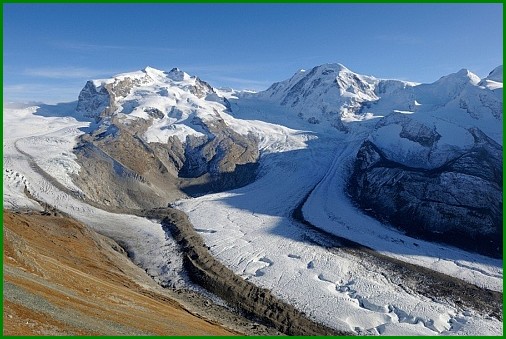In terrestrial weather problems blame the industrial revolution in terrestrial weather problems blame the industrial revolution, the other, apparently, is not given. In the industrial revolution is, however, the author, the name of that man.
The growth of air pollution as a result of the industrial revolution looks good solution to an old puzzle glaciological. Soot from the chimneys spread rapidly across Europe factories and locomotives - that's what made the Alpine glaciers retreat long before man-made global warming.
Massif of Monte Rosa (photo imagebroker / Alamy.)
4 thousand large and small alpine glaciers, which are now under threat of extinction due to the increasing temperature of the air felt fine during the five centuries of relatively cool period, which started at the end of XIII century and called the Little Ice. Maximum length and thickness of the ice, they reached the middle of the XIX century and at least twice its current size.
Then suddenly the glaciers began to retreat. Scientists have suggested that in other parts of the world it was the same (in fact, documented only the melting of glaciers in the Alps), and agreed to assume that the Little Ice Age ended soon after 1850.
However, despite the reduction of glaciers, the average global temperature began to increase significantly until the end of the century. Moreover, the alpine climate summaries (one of the most detailed and accurate in the world) suggests that the glaciers were to grow more than half a century, that is, until about 1910.
Glaciers are tormented something recorded by meteorologists - says a new study co-author George Kazer of the University of Innsbruck (Austria). - Some people think that the reason for the sharp decrease in winter precipitation, but this time the snow remained on the same level.
Two years ago, at a seminar in glaciological the Pontifical Academy of Sciences (Vatican) Mr. Kazer discussed the mystery with Thomas Painter of the NASA Jet Propulsion Laboratory, which studied the effects of atmospheric particles (aerosols) on climate. Could the soot formed by burning fossil fuels, to become the very elusive cause untimely melting of alpine glaciers?
New friends immediately began to investigate.
The darker the surface, the more it absorbs heat. If the snow and ice will settle certain amount of soot, melting accelerates. Historical documents indicate that by the middle of the last century air of some Alpine valleys has become very dirty.
Housewives Innsbruck longer to dry clothes on the street - emphasizes Mr. Kazer.
Apparently, the scientists who rejected the idea that blacks were enough to start melting glaciers were wrong. Group Mr. Kazera studied ice cores extracted in two places in the west of the Alps: Glacier in the saddle of Colle Gnifetti (4455 m above sea level), which is in the mountain massif of Monte Rosa, near the Swiss-Italian border, and on the glacier Fiescherhorn ( 3900 m) in the Bernese Alps.
It turned out that about 1860 in the layers of ice appears strikingly a lot of soot.
The researchers calculated the energy impact of soot on glaciers and transformed it into an equivalent temperature. In a simplified computer model of the mass balance of the actually observed increased air temperature obtained degrees, and soot perfectly explained alpine retreat!
With modeling, of course, be more work, but even in such a hypothesis is elegant and persuasive - says glaciologist Andreas Fili from the University of Zurich (Switzerland). - It seems that in Central Europe soot prematurely stopped the Little Ice Age.
Only about 1970, when the air quality has improved, the warming has accelerated and become a major factor in the retreat of alpine glaciers, says Mr. Kazer. If the glaciers continue to melt at a rate noted in the last 30 years, there is a danger that almost all of them will disappear by the end of the century.
in the wake of Proceedings of the National Academy of Sciences, Nature News, compulenta.computerra.ru